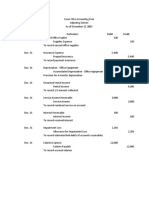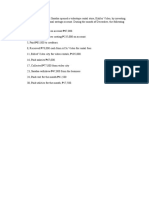Post-Closing Trial Balance
Post-Closing Trial Balance
Uploaded by
api-299265916Copyright:
Available Formats
Post-Closing Trial Balance
Post-Closing Trial Balance
Uploaded by
api-299265916Original Title
Copyright
Available Formats
Share this document
Did you find this document useful?
Is this content inappropriate?
Copyright:
Available Formats
Post-Closing Trial Balance
Post-Closing Trial Balance
Uploaded by
api-299265916Copyright:
Available Formats
Post-Closing Trial Balance
The last step in the accounting cycle is to prepare a post-closing trial balance.
A post-closing trial balance is prepared after closing entries are made and posted to the ledger.
It is the third trial balance prepared in the accounting cycle.
For a recap, we have three types of trial balance. They all have the same purpose (i.e. to test the equality
between debits and credits) although they are prepared at different stages in the accounting cycle.
1. Unadjusted trial balance - This is prepared after journalizing transactions and posting them to the
ledger. Its purpose is to test the equality between debits and credits after the recording phase.
2. Adjusted trial balance - This is prepared after adjusting entries are made and posted. Its purpose is to
test the equality between debits and credits after adjusting entries are prepared. It is also the basis in
preparing the financial statements.
An adjusted trial balance contains nominal and real accounts. Nominal accounts are those that are found
in the income statement, and withdrawals. Real accounts are those found in the balance sheet.
3. Post-closing trial balance - This is prepared after closing entries are made. Its purpose is to test the
equality between debits and credits after closing entries are prepared and posted. The post-closing trial
balance contains real accounts only since all nominal accounts have already been closed at this stage.
Example
To illustrate, here is a sample adjusted trial balance:
Gray Electronic Repair Services
Adjusted Trial Balance
December 31, 2014
Account Title
Debit
Credit
Cash
$ 7,480.00
Accounts Receivable
3,700.00
Service Supplies
600.00
Furniture and Fixtures
3,000.00
Service Equipment
16,000.00
Accumulated Depreciation
$
720.00
Accounts Payable
9,000.00
Utilities Payable
1,800.00
Loans Payable
12,000.00
Mr. Gray, Capital
13,200.00
Mr. Gray, Drawing
7,000.00
Service Revenue
9,850.00
Rent Expense
1,500.00
Salaries Expense
3,500.00
Taxes and Licenses
370.00
Utilities Expense
1,800.00
Service Supplies Expense
900.00
Depreciation Expense
720.00
Totals
$ 46,570.00 $ 46,570.00
At the end of the period, the following closing entries were made:
Dec 31 Service Revenue
9,850.00
Income Summary
31 Income Summary
9,850.00
8,790.00
Rent Expense
1,500.00
Salaries Expense
3,500.00
Taxes and Licenses
370.00
Utilities Expense
1,800.00
Service Supplies Expense
900.00
Depreciation Expense
720.00
31 Income Summary
Mr. Gray, Capital
1,060.00
1,060.00
31 Mr. Gray, Capital
7,000.00
Mr. Gray, Drawing
7,000.00
After posting the above entries, all the nominal accounts would zero-out, hence the term "closing entries".
Let's take a look.
In the first closing entry, Service Revenue was debited. Before that, it had a credit balance of 9,850 as
seen in the adjusted trial balance above. Now its balance would be zero.
Second entry. All expenses were credited. Before that, they had debit balances for the same amounts.
They would now have zero balances.
In the first and second closing entries, the balances of Service Revenue and the various expense
accounts were actually transferred to Income Summary, which is a temporary account. The Income
Summary account would have a credit balance of 1,060 (9,850 credit in the first entry and 8,790 debit in
the second).
Income Summary is then closed to the capital account as shown in the third closing entry.
And finally, in the fourth entry the drawing account is closed to the capital account. At this point, the
balance of the capital account would be 7,260 (13,200 credit balance, plus 1,060 credited in the third
closing entry, and minus 7,000 debited in the fourth entry).
Post-Closing Trial Balance Example
After incorporating the closing entries above, the post-closing trial balance would look like this:
Gray Electronic Repair Services
Post-Closing Trial Balance
December 31, 2014
Account Title
Debit
Credit
Cash
$ 7,480.00
Accounts Receivable
3,700.00
Service Supplies
600.00
Furniture and Fixtures
3,000.00
Service Equipment
16,000.00
Accumulated Depreciation
$
720.00
Accounts Payable
9,000.00
Utilities Payable
1,800.00
Loans Payable
12,000.00
Mr. Gray, Capital
7,260.00
Totals
$ 30,780.00 $ 30,780.00
The balances of the nominal accounts (income, expense, and withdrawal accounts) have been absorbed
by the capital account Mr. Gray, Capital. Hence, you will not see any nominal account in the postclosing trial balance.
And just like any other trial balance, total debits and total credits should be equal.
You might also like
- Lesson 16: Accounting Practice SetDocument47 pagesLesson 16: Accounting Practice SetMai Ruiz100% (1)
- Comprehensive Problem - Merchandising BusinessDocument1 pageComprehensive Problem - Merchandising BusinessJasper Andrew Adjarani80% (5)
- Cash and ReceivablesDocument30 pagesCash and ReceivablesAira Mae Hernandez CabaNo ratings yet
- FI Processes SCCDocument16 pagesFI Processes SCCGAANo ratings yet
- SAP SD Credit Memo, Debit Memo and Return OrderDocument21 pagesSAP SD Credit Memo, Debit Memo and Return Ordersumit patil100% (1)
- Crispin Rosales JournalizingDocument5 pagesCrispin Rosales JournalizingNightmare WolfNo ratings yet
- Jose Rizal Heavy Bombers Trial Balance: Totals P 44,793,750 P 44,793,750Document16 pagesJose Rizal Heavy Bombers Trial Balance: Totals P 44,793,750 P 44,793,750Sou TV0% (1)
- Accounting Problems and Exercises4 Accounting Cycle IllustrationDocument1 pageAccounting Problems and Exercises4 Accounting Cycle IllustrationMario Agoncillo50% (2)
- 14 AdjustmentsssDocument7 pages14 AdjustmentsssZaheer Ahmed SwatiNo ratings yet
- Acctg Closing Entries, Post Closing Trial Balance and Reversing EntriesDocument21 pagesAcctg Closing Entries, Post Closing Trial Balance and Reversing EntriesDaisy Marie A. Rosel100% (1)
- Activity Sheet Adjusting Entries DeferralsDocument1 pageActivity Sheet Adjusting Entries DeferralsShania Liwanag100% (1)
- 5 Adjusting Entries For Prepaid ExpenseDocument4 pages5 Adjusting Entries For Prepaid Expenseapi-299265916No ratings yet
- 3 How To Prepare A Balance SheetDocument4 pages3 How To Prepare A Balance Sheetapi-299265916100% (1)
- Financial Ratio AnalysisDocument4 pagesFinancial Ratio Analysisapi-299265916100% (1)
- 3 How To Prepare A Balance SheetDocument4 pages3 How To Prepare A Balance Sheetapi-299265916100% (1)
- 5 Journal Entries More ExamplesDocument4 pages5 Journal Entries More Examplesapi-299265916No ratings yet
- 5 Adjusting Entries For Prepaid ExpenseDocument4 pages5 Adjusting Entries For Prepaid Expenseapi-299265916No ratings yet
- Closing EntriesDocument4 pagesClosing Entriesapi-299265916100% (1)
- Adjusting Entries For StudentsDocument57 pagesAdjusting Entries For Studentsselvia egayNo ratings yet
- Journal Entries, Ledger and Trial BalanceDocument8 pagesJournal Entries, Ledger and Trial BalanceDan Ryan0% (1)
- At The End of The Accounting PeriodDocument16 pagesAt The End of The Accounting PeriodAra ArinqueNo ratings yet
- The Accounting Process: Adjusting The Accounts Cash Versus Accrual Basis of AccountingDocument12 pagesThe Accounting Process: Adjusting The Accounts Cash Versus Accrual Basis of AccountingKim Patrick Victoria100% (1)
- FAR Chapter4 FinalDocument43 pagesFAR Chapter4 FinalPATRICIA COLINANo ratings yet
- General Journal, GeveraDocument2 pagesGeneral Journal, GeveraFeiya LiuNo ratings yet
- Acctg 1 - PrelimDocument1 pageAcctg 1 - PrelimRalph Christer Maderazo80% (5)
- ANSWER KEY Adjustments Quiz 2Document6 pagesANSWER KEY Adjustments Quiz 2Christine Mae BurgosNo ratings yet
- Adjusting Journal Entries Are Entries Used To Update The Accounts Prior To The Preparation of Financial StatementsDocument4 pagesAdjusting Journal Entries Are Entries Used To Update The Accounts Prior To The Preparation of Financial Statementsjemima manzanoNo ratings yet
- Comprehensive ProblemDocument11 pagesComprehensive Problemapi-295660192No ratings yet
- Practice Problem Jenny Light AccountantDocument17 pagesPractice Problem Jenny Light AccountantFranco James Sanpedro100% (1)
- Exercise Periodic and PerpetualDocument4 pagesExercise Periodic and PerpetualYally100% (1)
- Journalizing Posting Trial Balance ExercisesDocument5 pagesJournalizing Posting Trial Balance ExerciseshIgh QuaLIty SVTNo ratings yet
- MerchandisingDocument11 pagesMerchandisingAIRA NHAIRE MECATE100% (1)
- Jesse Taylor Comprehensive Accounting ProblemDocument9 pagesJesse Taylor Comprehensive Accounting Problemapi-311367219No ratings yet
- ACC 1 Quiz No. 14 Answer KeyDocument9 pagesACC 1 Quiz No. 14 Answer Keynicole bancoroNo ratings yet
- Joannamarie Uy ProblemDocument1 pageJoannamarie Uy ProblemFeiya Liu50% (2)
- Example of Accounting TransactionDocument3 pagesExample of Accounting TransactionMylen Noel Elgincolin Manlapaz100% (1)
- ServiceDocument37 pagesServiceDanica Balleta0% (2)
- Santa Rosa Campus City of Santa Rosa, Laguna: Polytechnic University of The PhilippinesDocument19 pagesSanta Rosa Campus City of Santa Rosa, Laguna: Polytechnic University of The Philippinesareum100% (1)
- 77 FDocument3 pages77 FJohn CalvinNo ratings yet
- CHP 2 Exam Preparation ProblemsDocument3 pagesCHP 2 Exam Preparation ProblemsShawn JohnstonNo ratings yet
- Review Quiz No. 1Document6 pagesReview Quiz No. 1Charmaine CapaNo ratings yet
- Example of BookkepingDocument8 pagesExample of BookkepingMathew Visarra0% (1)
- Exercise 5 - Journalizing TransactionsDocument10 pagesExercise 5 - Journalizing TransactionsMichael DiputadoNo ratings yet
- Activity 6 - Adjusting Entries - Depreciation (Ans)Document5 pagesActivity 6 - Adjusting Entries - Depreciation (Ans)angela flores100% (1)
- Journalizing Closing Entries For A Merchandising EnterpriseDocument36 pagesJournalizing Closing Entries For A Merchandising EnterpriseRodolfo CorpuzNo ratings yet
- 2016 14 PPT Acctg1 Adjusting EntriesDocument20 pages2016 14 PPT Acctg1 Adjusting Entriesash wu100% (3)
- Moises Dondoyano Information Systems Company Trial Balance: Accounts Dr. CRDocument5 pagesMoises Dondoyano Information Systems Company Trial Balance: Accounts Dr. CR버니 모지코No ratings yet
- Assessment QuizDocument2 pagesAssessment QuizFrancis Raagas67% (3)
- Accounting For A Service CompanyDocument9 pagesAccounting For A Service CompanyAnnie RapanutNo ratings yet
- Unit II Lesson 5 and 6 ADJUSTING ENTRIES and FSDocument25 pagesUnit II Lesson 5 and 6 ADJUSTING ENTRIES and FSAlezandra SantelicesNo ratings yet
- Accounting Final OuputDocument14 pagesAccounting Final OuputMichaella DometitaNo ratings yet
- Accounting Problem 5Document8 pagesAccounting Problem 5Carlo AniNo ratings yet
- Adjusting EntriesDocument2 pagesAdjusting Entriesitsayuhthing100% (1)
- Journal Entries in Merchandising OperationsDocument4 pagesJournal Entries in Merchandising OperationsArrabela PalmaNo ratings yet
- Sample Problem For Last MeetingDocument11 pagesSample Problem For Last MeetingLylanie Alcoran AnibNo ratings yet
- #1-Illustrative ProblemDocument19 pages#1-Illustrative ProblemNisharie AbanNo ratings yet
- Problem 15Document1 pageProblem 15Alyssa Jane G. AlvarezNo ratings yet
- Book 1Document6 pagesBook 1ItsRenz YTNo ratings yet
- Fabm 1: Accounting For Merchandising ConcernDocument29 pagesFabm 1: Accounting For Merchandising ConcernJan Vincent A. LadresNo ratings yet
- Financial Accounting and Reporting Project Week 3Document3 pagesFinancial Accounting and Reporting Project Week 3Andrea Monique Alejaga100% (1)
- ACTIVITY. On February 1, 20A4, Mira Delamar Opened A Store That SellsDocument1 pageACTIVITY. On February 1, 20A4, Mira Delamar Opened A Store That SellsMiguel Lulab50% (4)
- Journalizing TransactionsDocument1 pageJournalizing TransactionsEddie Abing Lumaras Jr.No ratings yet
- Acc and BMDocument8 pagesAcc and BMShawn Mendez100% (1)
- Acctgchap 2Document15 pagesAcctgchap 2Anjelika ViescaNo ratings yet
- 8 Adjusted Trial BalanceDocument3 pages8 Adjusted Trial Balanceapi-299265916100% (1)
- 2 How To Prepare A Statement of OwnerDocument4 pages2 How To Prepare A Statement of Ownerapi-299265916No ratings yet
- 3 Income Statement ExamplesDocument3 pages3 Income Statement Examplesapi-299265916100% (1)
- Financial TableDocument9 pagesFinancial Tableapi-299265916No ratings yet
- 2 Liability AccountsDocument2 pages2 Liability Accountsapi-299265916No ratings yet
- 5 Expense AccountsDocument2 pages5 Expense Accountsapi-299265916No ratings yet
- 2 Income Statement FormatDocument3 pages2 Income Statement Formatapi-299265916No ratings yet
- 2 Qualitative Characteristics of Financial InformationDocument2 pages2 Qualitative Characteristics of Financial Informationapi-299265916No ratings yet
- 1 Asset AccountsDocument3 pages1 Asset Accountsapi-299265916No ratings yet
- 4 Revenue AccountsDocument1 page4 Revenue Accountsapi-299265916No ratings yet
- 4 Accounting PrinciplesDocument3 pages4 Accounting Principlesapi-299265916No ratings yet
- 1 How To Prepare An Income StatementDocument4 pages1 How To Prepare An Income Statementapi-299265916No ratings yet
- 3 Standards of Ethical Conduct For Management AccountantsDocument2 pages3 Standards of Ethical Conduct For Management Accountantsapi-299265916No ratings yet
- Reversing Entries Part 1Document3 pagesReversing Entries Part 1api-299265916100% (3)
- 2 How To Prepare A Statement of OwnerDocument4 pages2 How To Prepare A Statement of Ownerapi-299265916No ratings yet
- 8 Adjusted Trial BalanceDocument3 pages8 Adjusted Trial Balanceapi-299265916100% (1)
- 8 Correcting EntriesDocument3 pages8 Correcting Entriesapi-299265916No ratings yet
- 6 Adjusting Entry For Depreciation ExpenseDocument3 pages6 Adjusting Entry For Depreciation Expenseapi-299265916No ratings yet
- 7 Adjusting Entry For Bad Debts ExpenseDocument2 pages7 Adjusting Entry For Bad Debts Expenseapi-299265916No ratings yet
- 2 Adjusting Entry For Accrued RevenueDocument2 pages2 Adjusting Entry For Accrued Revenueapi-299265916No ratings yet
- 6 Posting To The LedgerDocument3 pages6 Posting To The Ledgerapi-299265916No ratings yet
- 3 Adjusting Entry For Accrued ExpensesDocument2 pages3 Adjusting Entry For Accrued Expensesapi-299265916No ratings yet
- 1 Understanding and Analyzing Business TransactionsDocument2 pages1 Understanding and Analyzing Business Transactionsapi-299265916100% (1)
- 3 Chart of AccountsDocument3 pages3 Chart of Accountsapi-299265916No ratings yet
- 2 Rules of Debit and CreditDocument3 pages2 Rules of Debit and Creditapi-2992659160% (1)
- 4 Journal EntriesDocument2 pages4 Journal Entriesapi-299265916No ratings yet
- 4 Balance SheetDocument2 pages4 Balance Sheetapi-299265916No ratings yet
- BAFS 1011 Midyear F4 ExamDocument8 pagesBAFS 1011 Midyear F4 Examqsoss433No ratings yet
- Analysis of Balance Sheet of 2007Document33 pagesAnalysis of Balance Sheet of 2007PakassignmentNo ratings yet
- Mark Scheme (Results) Summer 2016: Pearson Edexcel International GCSE Accounting (4AC0) Paper 1Document12 pagesMark Scheme (Results) Summer 2016: Pearson Edexcel International GCSE Accounting (4AC0) Paper 1Vraj PatelNo ratings yet
- Magadh University BBM 2ND YEAR QUESTIONSDocument13 pagesMagadh University BBM 2ND YEAR QUESTIONSSuryansh SinghNo ratings yet
- Organization Structure in SAP: B) Rules of AccountingDocument7 pagesOrganization Structure in SAP: B) Rules of AccountingVishnuprasad RNo ratings yet
- Finance Questions Generally Asked in Interview On Equity MarketDocument26 pagesFinance Questions Generally Asked in Interview On Equity MarketshubhamNo ratings yet
- Chapter 6 Soalan Subjektif & Jawapan For FasiDocument6 pagesChapter 6 Soalan Subjektif & Jawapan For FasiCHUAH CHEE XIAN MoeNo ratings yet
- Chapter Four: Adjusting Entries and The Work SheetDocument102 pagesChapter Four: Adjusting Entries and The Work SheetReijen InciongNo ratings yet
- Chapter 2 BuscomDocument92 pagesChapter 2 BuscomMariel EstañaNo ratings yet
- Sap FiglDocument55 pagesSap Figlheshamali99100% (2)
- Tally Erp 9 Notes in English PDF Free Download With ExamplesDocument13 pagesTally Erp 9 Notes in English PDF Free Download With ExamplesPrakash57% (7)
- BB ECCS GMM Workshop ResultDocument41 pagesBB ECCS GMM Workshop ResultAllan TaufiqNo ratings yet
- Itr3 2018 PR1Document148 pagesItr3 2018 PR1Harish Kumar MahavarNo ratings yet
- Nfjpia R11 Cup 1 - Fundamentals of Accounting EasyDocument9 pagesNfjpia R11 Cup 1 - Fundamentals of Accounting EasyBlessy Zedlav LacbainNo ratings yet
- Oracle Fusion Applications Financials Implementation Guide IIDocument222 pagesOracle Fusion Applications Financials Implementation Guide IIBalaji Shinde100% (1)
- Multinational Financial Management 10th Edition Shapiro Test Bank 1Document7 pagesMultinational Financial Management 10th Edition Shapiro Test Bank 1gerald100% (58)
- 001 Daftar Akun AkuntansiDocument15 pages001 Daftar Akun AkuntansiDiandra Nida AnisaNo ratings yet
- CAET QuestionsDocument23 pagesCAET QuestionsRajesh Kumar OjhaNo ratings yet
- Miltek Engineering WorksDocument2 pagesMiltek Engineering Workskk5860232No ratings yet
- Chapter 2Document53 pagesChapter 2Anh KhoaNo ratings yet
- Ahead LLC JanDocument9 pagesAhead LLC JanClyde Thomas67% (3)
- KASC-Commerce PA: Question BanksDocument427 pagesKASC-Commerce PA: Question BanksDilli Kumar100% (1)
- 2nd Grading Exam - Key Answers - 2Document26 pages2nd Grading Exam - Key Answers - 2Amie Jane Miranda75% (4)
- A Summer Internship Report (Ca)Document38 pagesA Summer Internship Report (Ca)Dìvyánshú ChøúdháryNo ratings yet
- Nov STM MP Prime PDFDocument2 pagesNov STM MP Prime PDFMarija Difrancesco100% (1)
- 2nd Training Session 2022 03 14 18 41 46Document24 pages2nd Training Session 2022 03 14 18 41 46Sara PiccioliNo ratings yet
- Farm Management RecordsDocument8 pagesFarm Management RecordsAishatu Musa AbbaNo ratings yet


















































































































